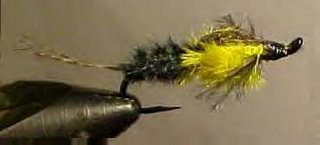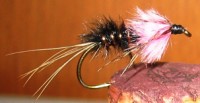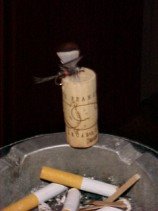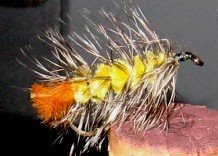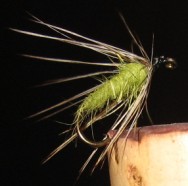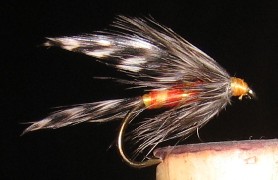 .. Jacklin's Rock Worm. We've highlighted this one before. See our original post HERE.
.. Jacklin's Rock Worm. We've highlighted this one before. See our original post HERE... Visit Jacklin's website to see the video HERE.
.. No warranty is implied or given. They may prove to be a bust if you tie and fish them. The patterns are not quite standardized, but can be replicated by most fishers with common materials. There is nothing exotic about the little darlings.
.. The photos are not meant to obscure. They just came out that way. Sorry 'bout that. Click on images for larger view.
 .. JERRY'S NORMAL: just another nymph with a brass bead head. The body is shredded mylar twisted with peacock herl, and ribbed with black thread. The thorax is dubbed hare's ear. The legs are partridge. The wing case is pheasant tail. The only unusual part is the orange goose biots used for the tail. Sizes are usually in 12 - 14 range but can be bigger or smaller.
.. JERRY'S NORMAL: just another nymph with a brass bead head. The body is shredded mylar twisted with peacock herl, and ribbed with black thread. The thorax is dubbed hare's ear. The legs are partridge. The wing case is pheasant tail. The only unusual part is the orange goose biots used for the tail. Sizes are usually in 12 - 14 range but can be bigger or smaller. .. JOHN'S STILLBORN: a very big, (for hook size,) bead head in front of a prickly body. The body is a mixture of hare's ear, antron, and muskrat. It is ribbed with Mylar tinsel and uses bits of badger fur for the tail. Sizes are usually in the 14 - 16 range.
.. JOHN'S STILLBORN: a very big, (for hook size,) bead head in front of a prickly body. The body is a mixture of hare's ear, antron, and muskrat. It is ribbed with Mylar tinsel and uses bits of badger fur for the tail. Sizes are usually in the 14 - 16 range. .. CAL'S FUZZY: a quick and dirty stream side creation that has lasted for several decades. Red thread with a hare's ear body is wrapped with French tinsel. The legs are coarse pheasant tail fibers, most of which are cut short. The tail is fibers from a furnace hackle. Big ugly heads are the norm, and no bead heads are used. Sizes are usually in the 14 - 18 range but are often larger.
.. CAL'S FUZZY: a quick and dirty stream side creation that has lasted for several decades. Red thread with a hare's ear body is wrapped with French tinsel. The legs are coarse pheasant tail fibers, most of which are cut short. The tail is fibers from a furnace hackle. Big ugly heads are the norm, and no bead heads are used. Sizes are usually in the 14 - 18 range but are often larger. .. JOHN'S ESCAPEE: a tightly dubbed and wrapped two-tone body of pink wool and hare's ear - followed by steel blue antron all over-wrapped with sanded copper wire. The legs are butt-fluff from either badger or furnace hackle, and the tail is badger fur. Heads are giant wads of thread, heavily lacquered with a spit shine. Sizes range from 8 to 16.
.. JOHN'S ESCAPEE: a tightly dubbed and wrapped two-tone body of pink wool and hare's ear - followed by steel blue antron all over-wrapped with sanded copper wire. The legs are butt-fluff from either badger or furnace hackle, and the tail is badger fur. Heads are giant wads of thread, heavily lacquered with a spit shine. Sizes range from 8 to 16. .. DEBBY'S DELIGHT: a good sized bug with all kinds of internal action. The body is red wool, purple antron, purple Mylar, and blue hare's ear. Shredded in Deb's coffee grinder and tightly dubbed and wrapped. Tubular rubber legs are covered with pheasant neck feathers and are followed by a tungsten bead head. Again, the dyed goose biots make their appearance as a tail in the neighborhood. Sizes can be as large as a 4 or 6, and may be as small as 10.
.. DEBBY'S DELIGHT: a good sized bug with all kinds of internal action. The body is red wool, purple antron, purple Mylar, and blue hare's ear. Shredded in Deb's coffee grinder and tightly dubbed and wrapped. Tubular rubber legs are covered with pheasant neck feathers and are followed by a tungsten bead head. Again, the dyed goose biots make their appearance as a tail in the neighborhood. Sizes can be as large as a 4 or 6, and may be as small as 10. .. MADISON MAULER: a neighborhood collaborative effort. Just a bit of plug-ugliness that works.
.. MADISON MAULER: a neighborhood collaborative effort. Just a bit of plug-ugliness that works... Time was when we complained about tying on small flies, then about not being able to hold them, and now about not being able to pick them up - or even see them.
.. Kind folks in the neighborhood put a bunch of these on bits of tippet for us. We can still tie a knot.
 .. The 'body' is big , fat, flat, green, tying thread that is heavily waxed and wrapped on the hook. It's some sort of mysterious space-age synthetic, (Kevlar?)
.. The 'body' is big , fat, flat, green, tying thread that is heavily waxed and wrapped on the hook. It's some sort of mysterious space-age synthetic, (Kevlar?).. The abdomen/thorax/legs portion is dubbed antron of three colors: yellow, followed by deep purple, (a single twist of peacock-eye herl is often used,) followed by lime green. Artistic license is granted in the tying. It is a football shape with legs that is the target. Heads vary and run toward the messy.
.. Hooks are small. Sizes range from 14 through 22. They all work very well. Pick your hook style. There is currently a bizarre argument about up eye vs. down eye. We're just not savvy enough to even participate.



